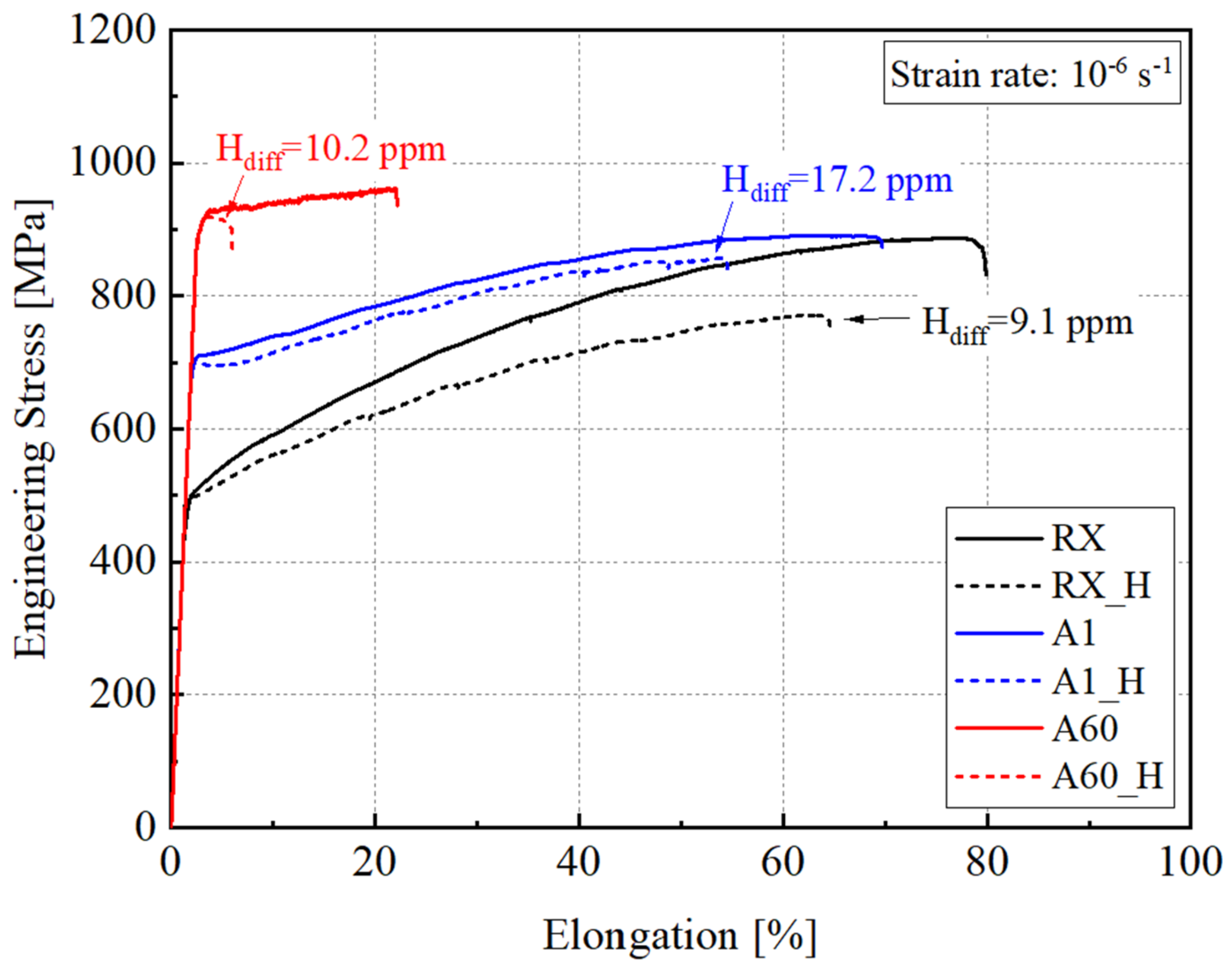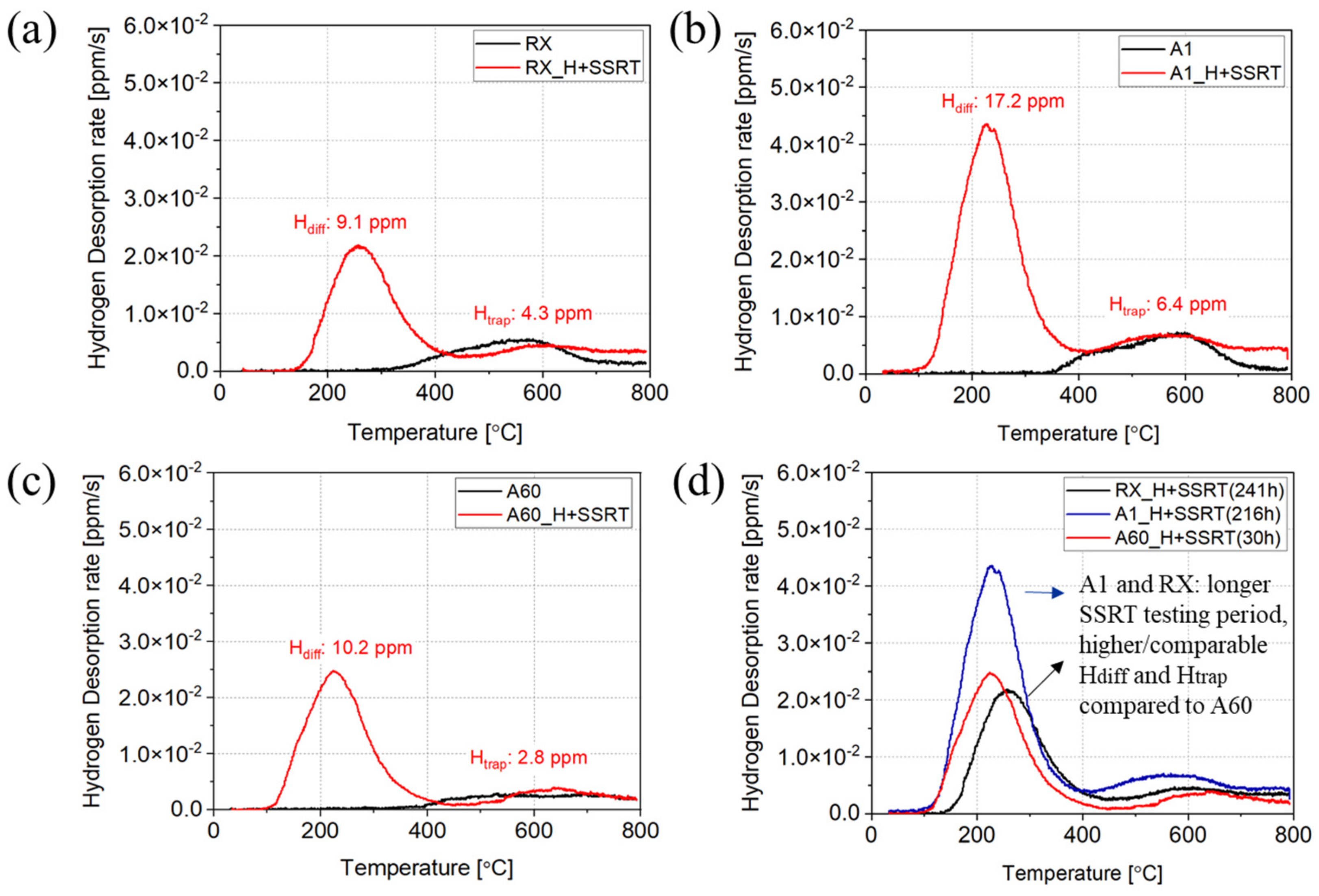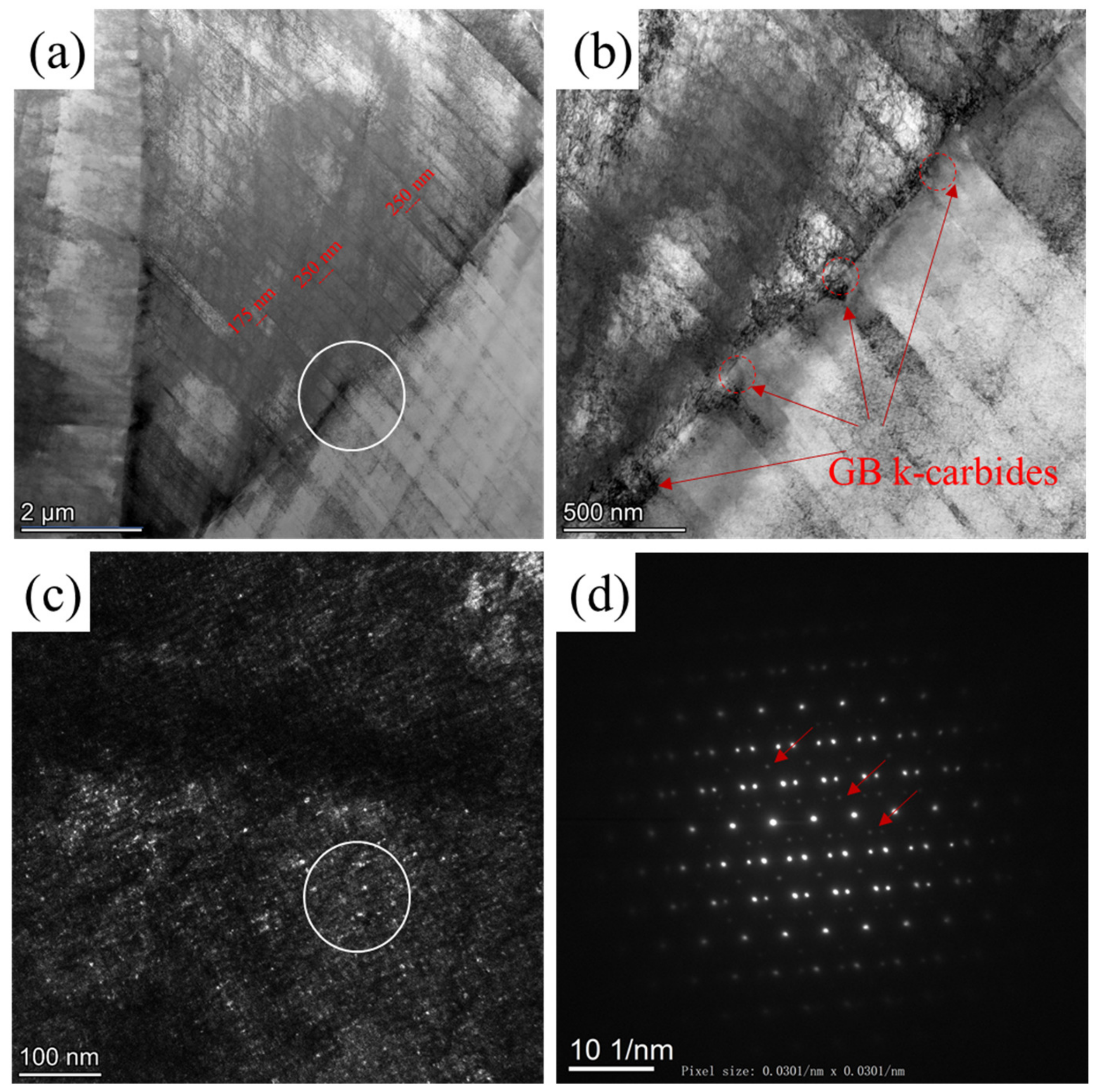Impact of Size and Distribution of k-Carbides on the Hydrogen Embrittlement and Trapping Behaviors of a Fe-Mn-Al-C Low-Density Steel
Abstract
:1. Introduction
2. Materials and Methods
3. Results
3.1. Microstructure and Mechanical Properties
3.2. Hydrogen Resistance Evaluated by Slow Strain Rate Test
3.3. Thermal Desorption Analysis
3.4. Fracture Surface Analysis
4. Discussion
5. Conclusions
- The material shows a fully recrystallized face-centered cubic microstructure with annealing twins and an average grain size of about 22 ± 5 μm. Aging promotes the precipitation of k-carbides in A1 specimens (2–4 nm, globular-shaped), as well as GB k-carbides of a similar size and shape. Conversely, A60 specimens exhibit coarsened intra-granular κ-carbides (7–9 nm, cuboidal-shaped) and coarse GB κ-carbides (above 100 nm), indicating faster coarsening at the grain boundary region.
- SSRT testing reveals an increasing HE susceptibility with aging time and larger κ-carbide sizes, reflected in a significant elongation reduction. A60 specimens display a mixed fracture mode with grain boundary decohesion, likely due to coarse grain boundary κ-carbides, reducing grain boundary cohesion and leading to the exacerbation of cracking behavior in the presence of hydrogen.
- TDS reveals higher diffusive and trapped hydrogen levels in the A1 specimens compared to RX and A60 specimens. The high trappability of diffusive hydrogen in A1 specimens is attributed to nano-sized globular κ-carbides. Conversely, A60 specimens exhibit the lowest diffusive and trapped hydrogen levels but a higher surface layer brittleness, suggesting an enhanced hydrogen embrittlement susceptibility due to microstructural sensitivity.
Author Contributions
Funding
Data Availability Statement
Acknowledgments
Conflicts of Interest
References
- Chen, S.; Rana, R.; Haldar, A.; Ray, R.K. Current State of Fe-Mn-Al-C Low Density Steels. Prog. Mater. Sci. 2017, 89, 345–391. [Google Scholar] [CrossRef]
- Rana, R.; Lahaye, C.; Ray, R.K. Overview of Lightweight Ferrous Materials: Strategies and Promises. Jom 2014, 66, 1734–1746. [Google Scholar] [CrossRef]
- Ding, H.; Liu, D.; Cai, M.; Zhang, Y. Austenite-Based Fe-Mn-Al-C Lightweight Steels: Research and Prospective. Metals 2022, 12, 1572. [Google Scholar] [CrossRef]
- Gutierrez-Urrutia, I. Low Density Steels. Encycl. Mater. Met. Alloys 2021, 2, 106–114. [Google Scholar] [CrossRef]
- Ma, T.; Gao, J.; Li, H.; Li, C.; Zhang, H.; Li, Y. Microband-Induced Plasticity in a Nb Content Fe–28Mn–10Al–C Low Density Steel. Metals 2021, 11, 345. [Google Scholar] [CrossRef]
- Liu, J.; Wu, H.; He, J.; Yang, S.; Ding, C. Effect of κ-Carbides on the Mechanical Properties and Superparamagnetism of Fe–28Mn–11Al-1.5/1.7C–5Cr Lightweight Steels. Mater. Sci. Eng. A 2022, 849, 143462. [Google Scholar] [CrossRef]
- Ren, P.; Chen, X.; Yang, M.J.; Liu, S.M.; Cao, W. Effect of Early Stage of Κ′-Carbides Precipitation on Tensile Properties and Deformation Mechanism in High Mn-Al-C Austenitic Low-Density Steel. SSRN Electron. J. 2022, 857, 2–12. [Google Scholar] [CrossRef]
- Li, M.C.; Chang, H.; Kao, P.W.; Gan, D. Effect of Mn and Al Contents on the Solvus of κ Phase in Austenitic Fe-Mn-Al-C Alloys. Mater. Chem. Phys. 1999, 59, 96–99. [Google Scholar] [CrossRef]
- Sato, K.; Tagawa, K.; Inoue, Y. Age Hardening of an Fe-30Mn-9Al-0.9C Alloy by Spinodal Decomposition. Scr. Metall. 1988, 22, 899–902. [Google Scholar] [CrossRef]
- Lee, J.; Park, S.; Kim, H.; Park, S.J.; Lee, K.; Kim, M.Y.; Madakashira, P.P.; Han, H.N. Simulation of κ-Carbide Precipitation Kinetics in Aged Low-Density Fe–Mn–Al–C Steels and Its Effects on Strengthening. Met. Mater. Int. 2018, 24, 702–710. [Google Scholar] [CrossRef]
- Choo, W.K.; Kim, J.H.; Yoon, J.C. Microstructural Change in Austenitic Fe-30.0wt%Mn-7.8wt%Al-1.3wt%C Initiated by Spinodal Decomposition and Its Influence on Mechanical Properties. Acta Mater. 1997, 45, 4877–4885. [Google Scholar] [CrossRef]
- Kimura, Y.; Handa, K.; Hayashi, K.; Mishima, Y. Microstructure Control and Ductility Improvement of the Two-Phase γ-Fe/κ-(Fe, Mn)3AlC Alloys in the Fe-Mn-Al-C Quaternary System. Intermetallics 2004, 12, 607–617. [Google Scholar] [CrossRef]
- Chao, C.Y.; Hwang, L.K.; Liu, T.F. Spinodal Decomposition in Fe9.0Al30.5MnxC Alloys. Scr. Metall. Mater. 1993, 29, 647–650. [Google Scholar] [CrossRef]
- Sato, K.; Tagawa, K.; Inoue, Y. Spinodal Decomposition and Mechanical Properties of an Austenitic Fe-30wt.%Mn-9wt.%Al-0.9wt.%C Alloy. Mater. Sci. Eng. A 1989, 111, 45–50. [Google Scholar] [CrossRef]
- Drouven, C.; Hallstedt, B.; Song, W.; Bleck, W. Experimental Observation of κ-Phase Formation Sequences by in-Situ Synchrotron Diffraction. Mater. Lett. 2019, 241, 111–114. [Google Scholar] [CrossRef]
- An, Y.F.; Chen, X.P.; Mei, L.; Ren, P.; Wei, D.; Cao, W.Q. Precipitation Transformation Pathway and Mechanical Behavior of Nanoprecipitation Strengthened Fe–Mn–Al–C–Ni Austenitic Low-Density Steel. J. Mater. Sci. Technol. 2024, 174, 157–167. [Google Scholar] [CrossRef]
- Pang, J.; Zhou, Z.; Zhao, Z.; He, Q.; Tang, D.; Liang, J. Tensile Behavior and Deformation Mechanism of Fe-Mn-Al-C Low Density Steel with High Strength and High Plasticity. Metals 2019, 9, 897. [Google Scholar] [CrossRef]
- Shun, T.; Wan, C.M.; Byrne, J.G. A Study of Work Hardening in Austenitic FeMnC and FeMnAlC Alloys. Acta Metall. Mater. 1992, 40, 3407–3412. [Google Scholar] [CrossRef]
- Ma, L.; Tang, Z.; You, Z.; Guan, G.; Ding, H.; Misra, D. Microstructure, Mechanical Properties and Deformation Behavior of Fe-28.7Mn-10.2Al-1.06C High Specific Strength Steel. Metals 2022, 12, 602. [Google Scholar] [CrossRef]
- Zhang, X.F.; Yang, H.; Leng, D.P.; Zhang, L.; Huang, Z.Y.; Chen, G. Tensile Deformation Behavior of Fe-Mn-Al-C Low Density Steels. J. Iron Steel Res. Int. 2017, 23, 963–972. [Google Scholar] [CrossRef]
- Gurgel, M.A.M.; de Souza Baêta Júnior, E.; da Silva Teixeira, R.; do Nascimento, G.O.; Oliveira, S.S.; Ferronatto Leite, D.N.; Moreira, L.P.; Brandao, L.P.; dos Santos Paula, A. Microstructure and Continuous Cooling Transformation of an Fe-7.1Al-0.7Mn-0.4C-0.3Nb Alloy. Metals 2022, 12, 1305. [Google Scholar] [CrossRef]
- Elkot, M.N.; Sun, B.; Zhou, X.; Ponge, D.; Raabe, D. Hydrogen-Assisted Decohesion Associated with Nanosized Grain Boundary κ-Carbides in a High-Mn Lightweight Steel. Acta Mater. 2022, 241, 118392. [Google Scholar] [CrossRef]
- Hwang, C.N.; Chao, C.Y.; Liu, T.F. Grain Boundary Precipitation in an Fe-8.0Al-31.5Mn-1.05C Alloy. Scr. Metall. Mater. 1993, 28, 263–268. [Google Scholar] [CrossRef]
- Liu, D.; Ding, H.; Han, D.; Cai, M. Materials Science & Engineering A Effect of Grain Interior and Grain Boundary κ -Carbides on the Strain Hardening Behavior of Medium-Mn Lightweight Steels. Mater. Sci. Eng. A 2023, 871, 144861. [Google Scholar] [CrossRef]
- Elkot, M.N.; Sun, B.; Zhou, X.; Ponge, D.; Raabe, D. On the Formation and Growth of Grain Boundary κ-Carbides in Austenitic High-Mn Lightweight Steels. Mater. Res. Lett. 2024, 12, 10–16. [Google Scholar] [CrossRef]
- Liu, D.; Ding, H.; Han, D.; Cai, M. Improvement of the Yield Strength of Fe-11Mn-XAl-YC Medium-Mn Lightweight Steels by Tuning Partial Recrystallization and Intra-Granular κ-Carbide Strengthening. Mater. Sci. Eng. A 2022, 833, 142553. [Google Scholar] [CrossRef]
- Sun, B.; Zhao, H.; Dong, X.; Teng, C.; Zhang, A.; Kong, S.; Zhou, J.; Zhang, X.-C.; Tu, S.-T. Current Challenges in the Utilization of Hydrogen Energy-a Focused Review on the Issue of Hydrogen-Induced Damage and Embrittlement. Adv. Appl. Energy 2024, 14, 100168. [Google Scholar] [CrossRef]
- Dwivedi, S.K.; Vishwakarma, M. Hydrogen Embrittlement in Different Materials: A Review. Int. J. Hydrogen Energy 2018, 43, 21603–21616. [Google Scholar] [CrossRef]
- Li, Y.; Li, W.; Min, N.; Liu, H.; Jin, X. Homogeneous Elasto-Plastic Deformation and Improved Strain Compatibility between Austenite and Ferrite in a Co-Precipitation Hardened Medium Mn Steel with Enhanced Hydrogen Embrittlement Resistance. Int. J. Plast. 2020, 133, 102805. [Google Scholar] [CrossRef]
- Koyama, M.; Springer, H.; Merzlikin, S.V.; Tsuzaki, K.; Akiyama, E.; Raabe, D. Hydrogen Embrittlement Associated with Strain Localization in a Precipitation-Hardened Fe-Mn-Al-C Light Weight Austenitic Steel. Int. J. Hydrogen Energy 2014, 39, 4634–4646. [Google Scholar] [CrossRef]
- Timmerscheidt, T.A.; Dey, P.; Bogdanovski, D.; von Appen, J.; Hickel, T.; Neugebauer, J.; Dronskowski, R. The Role of κ-Carbides as Hydrogen Traps in High-Mn Steels. Metals 2017, 7, 264. [Google Scholar] [CrossRef]
- Wei, F.G.; Tsuzaki, K. Quantitative Analysis on Hydrogen Trapping of TiC Particles in Steel. Metall. Mater. Trans. A Phys. Metall. Mater. Sci. 2006, 37, 331–353. [Google Scholar] [CrossRef]
- Welsch, E.; Ponge, D.; Hafez Haghighat, S.M.; Sandlöbes, S.; Choi, P.; Herbig, M.; Zaefferer, S.; Raabe, D. Strain Hardening by Dynamic Slip Band Refinement in a High-Mn Lightweight Steel. Acta Mater. 2016, 116, 188–199. [Google Scholar] [CrossRef]
- Park, K.T.; Jin, K.G.; Han, S.H.; Hwang, S.W.; Choi, K.; Lee, C.S. Stacking Fault Energy and Plastic Deformation of Fully Austenitic High Manganese Steels: Effect of Al Addition. Mater. Sci. Eng. A 2010, 527, 3651–3661. [Google Scholar] [CrossRef]
- Kim, S.D.; Park, J.Y.; Park, S.J.; Jang, J.H.; Moon, J.; Ha, H.Y.; Lee, C.H.; Kang, J.Y.; Shin, J.H.; Lee, T.H. Direct Observation of Dislocation Plasticity in High-Mn Lightweight Steel by in-Situ TEM. Sci. Rep. 2019, 9, 15171. [Google Scholar] [CrossRef] [PubMed]
- Gerold, V.; Karnthaler, H.P. On the Origin of Planar Slip in f.c.c. Alloys. Acta Metall. 1989, 37, 2177–2183. [Google Scholar] [CrossRef]
- Cheng, H.; Lu, X.; Zhou, J.; Lu, T.; Sun, B.; Zhang, X.C.; Tu, S.T. The Influence of L12 Ordered Precipitates on Hydrogen Embrittlement Behavior in CoCrNi-Based Medium Entropy Alloys. Acta Mater. 2023, 260, 119328. [Google Scholar] [CrossRef]
- Kim, H.J.; Cho, M.K.; Kim, G.; Lee, S.Y.; Jo, M.G.; Kim, H.; Suh, J.Y.; Lee, J. Influence of Hydrogen Absorption on Stacking Fault of Energy of a Face-Centered Cubic High Entropy Alloy. Met. Mater. Int. 2022, 28, 2637–2645. [Google Scholar] [CrossRef]






| Elements | Fe | C | Si | Mn | S | Al |
|---|---|---|---|---|---|---|
| wt.% | balanced | 1.27 | 0.09 | 29.65 | 0.02 | 8.38 |
Disclaimer/Publisher’s Note: The statements, opinions and data contained in all publications are solely those of the individual author(s) and contributor(s) and not of MDPI and/or the editor(s). MDPI and/or the editor(s) disclaim responsibility for any injury to people or property resulting from any ideas, methods, instructions or products referred to in the content. |
© 2024 by the authors. Licensee MDPI, Basel, Switzerland. This article is an open access article distributed under the terms and conditions of the Creative Commons Attribution (CC BY) license (https://creativecommons.org/licenses/by/4.0/).
Share and Cite
Xiong, Y.; Guo, X.; Dong, H. Impact of Size and Distribution of k-Carbides on the Hydrogen Embrittlement and Trapping Behaviors of a Fe-Mn-Al-C Low-Density Steel. Materials 2024, 17, 2698. https://doi.org/10.3390/ma17112698
Xiong Y, Guo X, Dong H. Impact of Size and Distribution of k-Carbides on the Hydrogen Embrittlement and Trapping Behaviors of a Fe-Mn-Al-C Low-Density Steel. Materials. 2024; 17(11):2698. https://doi.org/10.3390/ma17112698
Chicago/Turabian StyleXiong, Yinchen, Xiaofei Guo, and Han Dong. 2024. "Impact of Size and Distribution of k-Carbides on the Hydrogen Embrittlement and Trapping Behaviors of a Fe-Mn-Al-C Low-Density Steel" Materials 17, no. 11: 2698. https://doi.org/10.3390/ma17112698






